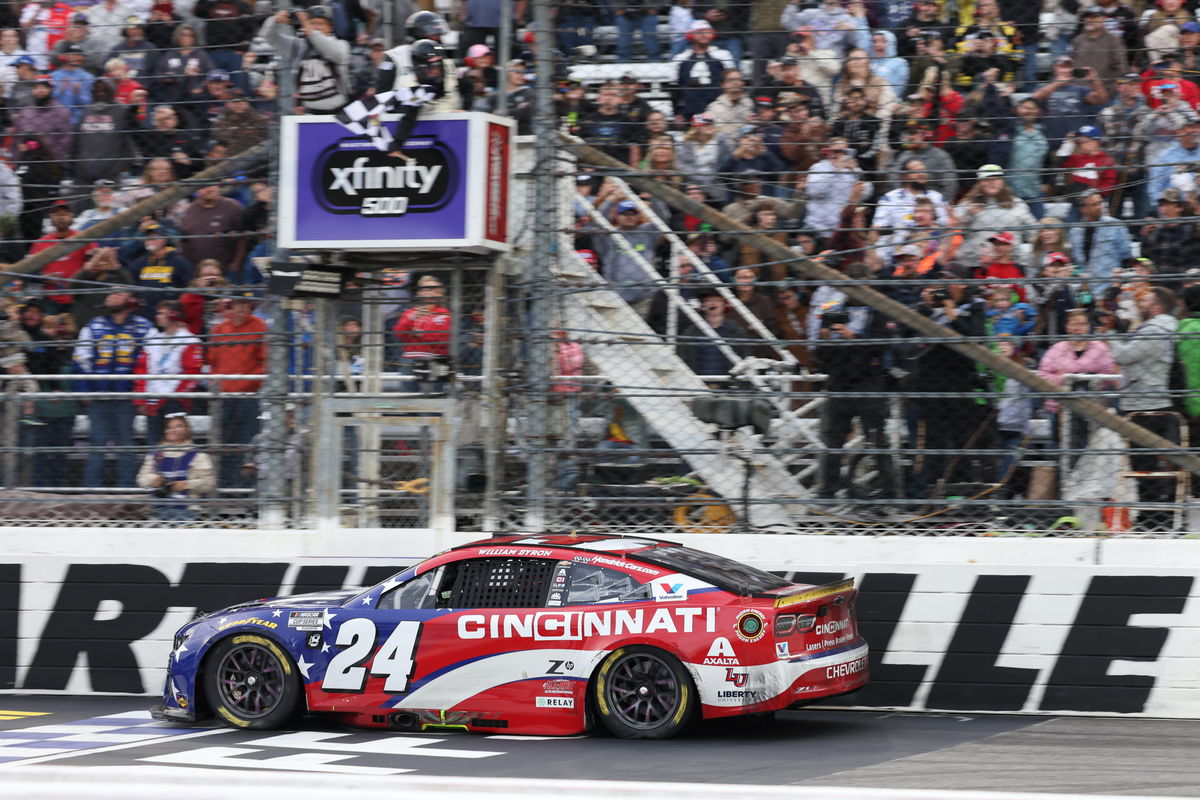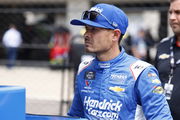
Imago
NASCAR, Motorsport, USA NASCAR Cup Series Playoff Race at Martinsville Oct 26, 2025 Martinsville, Virginia, USA NASCAR Cup Series driver William Byron 24 wins the Xfinity 500 at Martinsville Speedway. Martinsville Martinsville Speedway Virginia USA, EDITORIAL USE ONLY PUBLICATIONxINxGERxSUIxAUTxONLY Copyright: xGregxAtkinsx 20251026_sns_yr6_00220

Imago
NASCAR, Motorsport, USA NASCAR Cup Series Playoff Race at Martinsville Oct 26, 2025 Martinsville, Virginia, USA NASCAR Cup Series driver William Byron 24 wins the Xfinity 500 at Martinsville Speedway. Martinsville Martinsville Speedway Virginia USA, EDITORIAL USE ONLY PUBLICATIONxINxGERxSUIxAUTxONLY Copyright: xGregxAtkinsx 20251026_sns_yr6_00220
There was a time when the sight of a NASCAR Cup Series champion like Kyle Busch or Kevin Harvick dominating the lower circuits was routine, often overshadowing the full-time contenders. This constant Cup-washing of the Xfinity and Truck Series led NASCAR officials to eventually draw a firm line in the sand, dramatically restricting the elite Cup drivers from racing there.
Watch What’s Trending Now!
Beginning the 2020 season, a new rule stated that any driver with three or more years of full-time Cup Series experience could compete just five races maximum in both the Xfinity Series and the Truck Series annually. This was a significant move, often unofficially dubbed the “Kyle Busch Rule” due to his record-breaking success in the lower tiers. But NASCAR has turned the tables again.
ADVERTISEMENT
NASCAR promotes dual-series participation again
NASCAR has officially confirmed that significant changes are on the horizon for driver eligibility across its national series in 2026. For the first time since 2020, the sanctioning body is revising the participation rules for Cup Series competitors who race in the lower divisions. Under the new framework, Cup drivers with more than three years of full-time experience will now be permitted to run up to 10 races in the O’Reilly Auto Parts Series, instead of five.
Similarly, NASCAR’s Craftsman Truck Series will also see an increase, with Cup drivers allowed to make eight starts per season, up from five. Despite these expanded opportunities, NASCAR will maintain several key restrictions to preserve the integrity of its developmental divisions. Cup drivers will still not able to take part in the regular-season finale or playoff races across both the O’Reilly Auto Parts and Truck Series.
Additionally, NASCAR is adjusting its age-related entry requirements to create a clearer progression ladder for young talent. Beginning in 2026, drivers as young as 17 years old will be eligible to race in the O’Reilly Auto Parts Series, but only on road courses and ovals measuring 1.25 miles or shorter. This change aligns the system so that the minimum ages are now set at 16 for Truck, 17 for O’Reilly Auto Parts, and 18 for Cup competition.
ADVERTISEMENT
News: NASCAR is going to expand the eligibility rules for Cup Series drivers competing in the O’Reilly Auto Parts and Craftsman Truck Series, allowing them to run more races in 2026. Details: https://t.co/EZNCppgPns
— Kelly Crandall (@KellyCrandall) November 1, 2025
Explaining the reasoning behind these updates, Meghan Miley, NASCAR’s managing director of racing operations, said, “We look at these eligibility requirements on a yearly basis and if it’s still making sense. We’ve made adjustments in the past. In 2025, we allowed Cup drivers to participate in Dash 4 Cash and the Triple Truck Challenge.”
ADVERTISEMENT
She continued, “When we looked again this year, as we always do, we felt that potentially expanding the eligibility of both of those series could benefit both competition and marketing. I think we hear a lot of the drivers love competing with the top talent; it’s a development series, and it’s important that they get that track time, and we’ve heard that time and time again on the driver’s side.”
The decision is expected to have an immediate impact on the competitive landscape. Cup regulars known for ‘double-dipping’ on race weekends will now have a broader window to participate in the lower divisions. Ross Chastain, who will share an O’Reilly Auto Parts Series seat with Shane van Gisbergen at JR Motorsports, intends to take full advantage of the new 10-race allowance.
Miley further highlighted that the move could be mutually beneficial for the sport’s business ecosystem, saying, “There are benefits from a marketing perspective and from more eyeballs on the sport, potentially, so I think it’s good from a track perspective and with our broadcast partners. Expanding it a little bit potentially creates a little bit more benefit for a number of our stakeholders.”
ADVERTISEMENT
This move, when initially circulated last month, had gotten support from various Cup drivers, like Carson Hocevar, who said, “Yeah, I mean, I think any time you’re racing a Cup guy in Trucks or Xfinity, you know, ultimately their owners are watching that and that’s how they really grade it.” Kyle Busch himself stated that a driver in the lower series is judged by the way they fare against the premier tier drivers.
Hendrick Motorsports drivers are also expected to continue their involvement through JR Motorsports entries. Some team owners have welcomed the update, arguing that Cup-level talent provides valuable mentorship for younger drivers within their organizations. However, not everyone is pleased, as one Xfinity Series team owner said that he was ‘hurt’ by the rule change, believing it could dilute the series’ distinct identity.
Top Stories
Footage Surfaces of Florida Police Arresting NASCAR Veteran Over Disturbing Public Misbehavior

Denny Hamlin Demands Immediate Apology From FOX Broadcaster After Michael Jordan’s Lawsuit Triumph

Jeff Gordon’s Wife Ingrid Vandebosch Shares Tearful Message Amidst Major Family Announcement

Kyle Larson’s Sprint Car Rivals Threatens Criminal Action Against Track Owner Over $15,000 Winner’s Purse

Hailie Deegan & Others Speculated to Fill NASCAR Seat After Star Driver’s Ugly Exit

ADVERTISEMENT
HMS’s ally plans multi-driver truck lineup for 2026
The recent change by NASCAR to increase the number of lower series races eligible for Cup Series drivers is immediately impacting team strategies, with Spire Motorsports reportedly planning a significant expansion of its NASCAR Craftsman Truck Series program in 2026. Cup Series rookie Carson Hocevar is expected to be one of the drivers maximizing the new limits, using the opportunity to run a fuller schedule.
Critically, the limit of 8-10 races only applied to Cup drivers with more than 3 years of full-time experience, which Hocevar does not yet have, allowing for greater flexibility in his driving duties and an increase in his overall seat time. Spire Motorsports is positioning itself to field at least two full-time trucks next season, with potential plans to grow to three entries.
The team has confirmed an interesting split strategy for one of its rides, with Hocevar driving a truck for the initial portion of the season. This arrangement is designed to mentor and bridge the gap until their highly touted development driver, Tristan McKee, turns 16 in August, at which point the young talent will be eligible to make his debut in the Truck Series.
ADVERTISEMENT
McKee, a Spire development driver who won in the ARCA Menards Series debut five days after turning 15, is a key component of the team’s long-term future. The other primary Spire truck is anticipated to operate as a high-profile “All-Star” entry, featuring a rotation of top-tier talent and NASCAR champions.
This strategy leverages the increased race limits for experienced Cup drivers like Kyle Busch and Michael McDowell, who also drive full-time for Spire in the Cup Series, to generate significant exposure and provide performance benchmarks for the younger drivers.
This mix of established veterans and emerging prospects demonstrated how teams are planning to utilize the new rule structure for both immediate performance gains and the long-term development of their racing pipeline.
ADVERTISEMENT
ADVERTISEMENT
ADVERTISEMENT
ADVERTISEMENT

